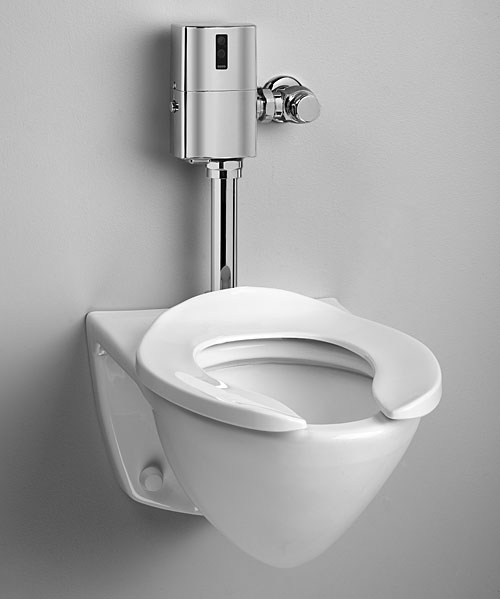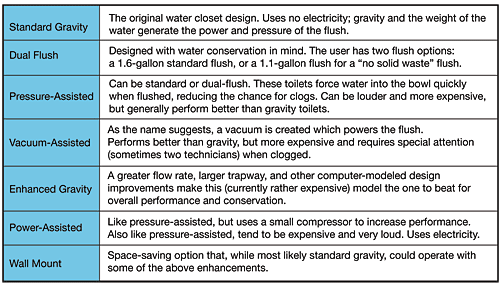Precious Water: Sustainable Indoor Water Systems
Modern Bathroom Fixture Technologies
Let's assume, for a moment, the best of all possible worlds. Your client is deeply committed to sustainability and is building a massive project with a loose schedule and an unlimited budget. You now have every possible advantage in designing and building a fully green monster. As you arrive at the task of selecting and specifying products and systems for the bathrooms, what must you consider to secure your place in the pantheon of modern sustainable design?
High-efficiency toilets. Begin with the basics. Many products will be labeled "High Efficiency," but what does that mean? As it happens, the EPA has created a set of specifications and requirements for high-efficiency toilets (HETs), which conform to the following performance specifications:
- Water Consumption of 1.28Gpf/4.8Lpf or less at original factory setting.
- Water Consumption of 1.68Gpf/6.8Lpf or less with tank
trim adjustment.
a) Fill valve set to highest setting (1/2 inch below overflow tube)
b) Pilot-style fill valve or ballcock with minimum fluctuation in water level
c) Extra buoyant after-market flapper - 350g "uncased" waste removal with trap seal restoration
- Meets all ASME performance requirements
The EPA also has standards for a number of products, but reserves the use of the term "high efficiency" for toilets only. The California Urban Water Conservation Council in Sacramento has created standards for other high-efficiency products, and is encouraging the use of these products by offering rebates. These include toilets, urinals of less than 0.5 gpf, clothes washers, and even a pressurized water broom, which is meant to replace high-pressure spraying for the cleaning of sidewalks and similar surfaces.
Sensor-operated fixtures represent another category of product that offers new solutions and challenges. Each of us is likely to have encountered this technology, as it is commonly used in public restrooms to operate faucets, toilets and urinals, as well as non-water bearing devices such as hand dryers and soap dispensers. The sensors use infrared emissions which, when reflected back to the sensor by the proximity of the user, signal the device to begin to operate.
Sensor-operated fixtures. Sensor technology offers a number of advantages and flexibilities to designers of public washrooms, and not all of them relate to water efficiency. Because the user needn't touch the fixtures to operate them, sensor-operated devices tend to be cleaner and more sanitary. Also, because the user does not mechanically operate them, they are less likely to break from abuse, misuse or overuse, thus reducing maintenance costs. Most sensor devices have a very positive life-cycle assessment.
Water conservation is a major reason for the employment of sensors, however, and a 30 percent reduction in water consumption is generally the result. Flexibility of use is a major contributor to their success. Faucet sensors, for instance, can be set to start either as a direct result of user proximity; based on user proximity and then stop after a set time; or by detecting the user and starting momentarily afterwards, among the options. In the case of toilets and urinals, the operation begins when the sensor no longer detects the user, and some sensor-operated toilets feature a button for optional manual use in the event of sensor failure. Still others disable the manual switch for a period of time after a flush, in order to discourage unnecessary extra flushes.
Cost-effective and sustainable, sensor-operated fixtures are effective in operations and are a good retrofit option.
|
Comparing and Specifying Toilets
Sensor-operated or otherwise, flush toilets represent a significant challenge to the conservation-minded. As mentioned earlier, toilets can consume up to one-third of the total water used in most buildings. When creating specifications for green washrooms, the type of toilet implemented will make a significant difference. The table shows the basic types of toilet fixtures.
Commercial toilets are procured as two separate parts: the bowl and the flush valve. (Residential toilet fixtures will generally, but not as a rule, be marketed and sold as a unit.) As such, it is crucial to understand not only what flush valves are available, but how they perform when paired with particular bowl-types.
|
Flush valves have been the preferred flushing device for commercial, institutional and industrial applications for more than 80 years. The metal finish is generally sanitary and vandal-resistant, while the technology provides a short post-flush recovery time and adaptability to new technologies such as sensor operation. There are two main categories of flush valves: piston-operated and diaphragm operated.
As the technology improves, both types of flush valves are becoming more and more sustainable. Ultra-smooth bowl glazings improve water flow, while chemical and corrosive-resistant materials, as well as filter systems, are incorporated into the designs of piston and diaphragm internal components in order to extend the device life and reduce the likelihood of unnecessary valve run-on.
An important consideration in terms of performance and conservation is pairing: which bowls work best with which valves? In general, it may be advantageous to match bowls and valves from the same manufacturer, assuming that those making both components understand best how one benefits, or improves the performance of, the other. Using this rationale, some sustainability advocates contend that "paired performance" of bowls and valves is likely to be an increasingly common measure of performance in overall indoor water efficiency. As water efficiency becomes a more highly sought-after aspect of high-performance sustainable buildings, one can expect paired performance to become the norm, and may perhaps be included as a baseline in some standards for commercial washrooms.











